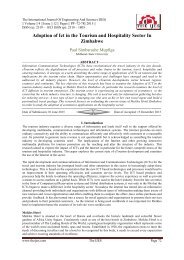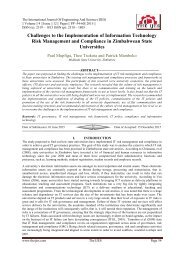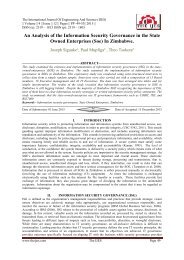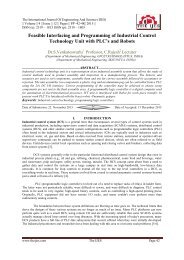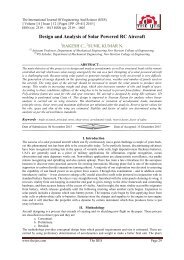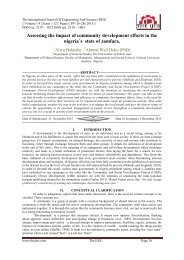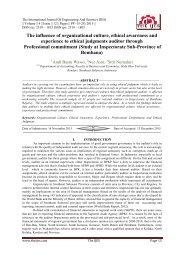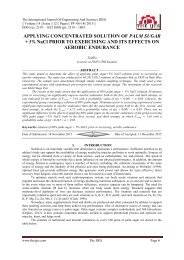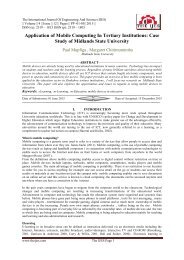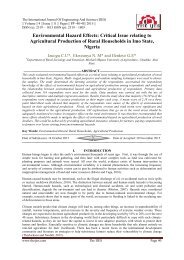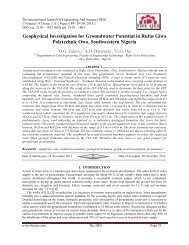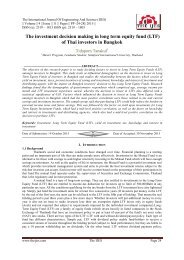Adaptive Image Contrast with Binarization Technique for Degraded Document Image
You also want an ePaper? Increase the reach of your titles
YUMPU automatically turns print PDFs into web optimized ePapers that Google loves.
<strong>Adaptive</strong> <strong>Image</strong> <strong>Contrast</strong> With <strong>Binarization</strong>…<br />
Post Processing : Problems <strong>with</strong> a picture that require some post processing. Cleaning and sharpening<br />
techniques can reduce noise, increase contrast, tighten the crop of the image, and make other small changes to<br />
the way the picture appears. <strong>Image</strong> post processing can also involve removing things from the frame when they<br />
don't belong or distract. A wildlife photographer, <strong>for</strong> example, might not want a radio tracker implanted on a<br />
bird's wing to be visible, because it could take away from the image. In post processing, the photographer can<br />
carefully edit it out.<br />
<strong>Contrast</strong> <strong>Image</strong> : The image gradient has been widely used <strong>for</strong> edge detection and it can be used to detect the<br />
text stroke edges of the document images effectively that have a uni<strong>for</strong>m document background. On the other<br />
hand, it often detects many non stroke edges from the background of degraded document that often contains<br />
certain image variations due to noise, uneven lighting, bleed-through, etc. To extract only the stroke edges<br />
properly, the image gradient needs to be normalized to compensatethe image variation <strong>with</strong>in the document<br />
background . The local contrast evaluated by the local image maximum and minimum is used to suppress the<br />
background variation. In particular, the numerator (i.e. the difference between the local maximum and the local<br />
minimum) captures the local image difference that is similar to the traditional image gradient .The denominator<br />
is a normalization factor that suppresses the image variation <strong>with</strong>in the document background. For image pixels<br />
<strong>with</strong>in bright regions, it will produce a large normalization factor to neutralize the numerator and accordingly<br />
result in a relatively low image contrast. For the image pixels <strong>with</strong>in dark regions, it will produce a small<br />
denominator and accordingly result in a relatively high image contrast. However, the image contrast in this is a<br />
typical limitation that it may not handle document images <strong>with</strong> the bright text properly. This is because a weak<br />
contrast will be calculated <strong>for</strong> stroke edges of the bright text where the denominator will be large but the<br />
numerator will be small. To overcome this over-normalization problem, we combine the local image contrast<br />
<strong>with</strong> the local image gradient .<br />
Text Stroke Edge Pixel Detection : The purpose of the contrast image construction is to detect the stroke edge<br />
pixels of the document text properly. The constructed contrast image has a clear bi-modal pattern, where the<br />
adaptive image contrast computed at text stroke edges is obviously larger than that computed <strong>with</strong>in the<br />
document background.We there<strong>for</strong>e detect the text stroke edge pixel candidate by using Otsu’s global<br />
thresholding method. For the contrast images a binary map by Otsu’s algorithm that extracts the stroke edge<br />
pixels properly. As the local image contrast and the local image gradient are evaluated by the difference<br />
between the maximum and minimum intensity in a local window, the pixels at both sides of the text stroke will<br />
be selected as the high contrast pixels. The binary map can be further improved through the combination <strong>with</strong><br />
the edges by Canny’s edge detector, because Canny’s edge detector has a good localization property that it can<br />
mark the edges close to real edge locations in the detecting image. In addition, canny edge detector uses two<br />
adaptive thresholds and is more tolerant to different imaging artifacts such as shading . It should be noted that<br />
Canny’s edge detector by itself often extracts a large amount of non-stroke edges <strong>with</strong>out tuning the parameter<br />
manually. In the combined map, we keep only pixels that appear <strong>with</strong>in both the high contrast image pixel map<br />
and canny edge map.The combination helps to extract the text stroke edge pixels accurately.<br />
www.theijes.com The IJES Page 21



